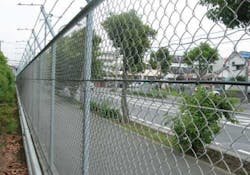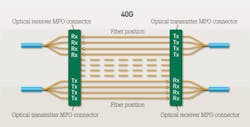TECHNOLOGY: Maximizing the efficiency of high-power Power over Ethernet
BY SANI RONEN, MICROSEMI
Power over Ethernet (PoE) technology has made it significantly easier to deploy network access points and terminals, by enabling them to be powered over the same cabling that delivers data. The industry has steadily increased the amount of power that PoE can deliver over Ethernet cabling so that a broader range of devices can be supported, from pan/tilt/zoom (PTZ) cameras and 802.11n access points to access control systems and thin clients. With the advent of high-power IEEE 802.3at standards, it is more important than ever to deliver power as efficiently as possible.
Several approaches can be taken to improving PoE efficiency. The first is the use of midspans with distributed power architectures and remote-management capabilities that enable better overall system efficiency. The second is four-pair powering, which can be implemented in an energy-saving mode to dissipate up to half the power and consume almost 15 percent less energy than conventional two-pair solutions.
A closer look at power efficiency
PoE system efficiency is calculated by multiplying power supply efficiency by the following factors: Power sourcing equipment (PSE) circuit efficiency, channel efficiency (including cable, patch panel and connectors), powered device (PD) efficiency, and PD DC/DC efficiency. These factors span the entire power chain, from power conversion (100-240VAC to 44-57VDC) at the output of the PoE PSE, through delivery to the PD at 37-37VDC, and on through conversion back to the various required voltages (5V, 3.3V, 2,5V, 1.2V, 09.V, etc.).
Power efficiency can be improved by minimizing system losses. Little can be done on the PD side, since one must assume worst-case power dissipation (converting the full 57VDC to its lowest voltage). But there is considerable room to improve efficiency on the PSE side, simply by selecting the optimal output voltage.
Consider an IEEE 802.3at PD requiring 25.5 W of power, connected to a 300-foot Category 5 cable with 12.5-ohm resistance. PSE circuit resistance is 0.65 ohms and PD circuit resistance is 0.58 ohms. In this scenario, a PSE power supply with a 50.4V minimum guaranteed voltage would require 600 mA current and derive 84 percent efficiency, while a 54.8V minimum power supply voltage would result in a 534mA current with 87 percent efficiency. The 54.8V number was picked so one could implement a power supply with a nominal voltage such that a ±2 percent regulation would not go over 57V, which is the maximum allowed by the IEEE 802.3 standard.
Assuming 90 percent efficiency in both the PD's DC/DC stage and the power supply's AC/DC stage, overall system efficiency of the 54.8V solution at full IEEE 802.3at load is 70.5 percent (90 percent x 90 percent x 87 percent). This contrasts with 50- to 70-percent efficiency at maximum load for a typical standalone AC adapter.
Maximizing efficiency through midspans
The most energy-efficient way to deploy high-power PoE is using midspans that are installed between the existing switch and the network's PD. Unlike switches with integral PoE capabilities, midspans decouple the power and data infrastructures, optimizing deployment flexibility and scalability by enabling the incremental addition of PoE ports as they are needed. Midspans are ideal when there is no need to upgrade the network switch, and they can be specified in a wide range of port densities.
More importantly, from an efficiency perspective, midspans use distributed power architectures so that they solve the problem of quiescent power losses with PoE-enabled switches. They also offer remote-management and energy-saving capabilities that are not available with PoE-enabled switches.
Consider a 48-port switch with 800 W of full IEEE 802.3af power per port, which might waste 80 W of quiescent power because as few as 20 ports are used at any given time. In high-power IEEE 802.3at applications, it is rare for any single port to require full power. Today's enterprise-grade midspans eliminate this problem by augmenting smaller, more-economical internal default power supplies with external power supplies for incremental additional power when needed, or for redundancy. This distributed architecture improves system efficiency and reduces cooling costs because smaller supplies require smaller and/or lower-speed fans.
Additionally, midspans feature remote-management capabilities that provide an easy way to power selected ports up or down during the day, which can reduce power consumption by 70 percent. Each device's power consumption can be measured and its average power consumption can be actively reduced. Consider a typical 1U, 24-port midspan, for which there will be 24x15.4W, or 370 W of power to manage. The real-time power needs of the various PDs on the network might only be slightly more than half that requirement.
Of course, power management must be executed in a secure fashion, so that malicious agents do not interfere with network operations. The latest high-power PoE midspans include a variety of secure, advanced power-management features, including Simple Network Management Protocol (SNMP) power modules and Web-based power management along with flexible power-management capabilities, plus support for both IPv4 and IPv6 addressing for energy-efficient remote device control and monitoring. Interconnected midspans can be used to back each other up in case of a power-supply failure, and there are a variety of flexible powering options from AC, DC or another midspan. DC inputs can be used with external power supplies to increase midspan power capacity or provide redundancy.
Midpsans also diminish heat concentration and associated cooling challenges in telecommunications rooms. By delivering only the power necessary, they are significantly more "green" than PoE switches. Midspans can be used alone or combined with PoE switches to power both low- and high-power devices for the most energy-efficient solution.
Four-pair powering
For even better power efficiency, four-pair powering can be used to power two-pair devices with 30 W of power, while dissipating up to half the power and consuming almost 15 percent less energy than conventional two-pair solutions.
Four-pair powering is supported in the latest high-power PoE standards, and uses all four pairs of Ethernet cable to enable up to 60 W of DC power to be delivered over a single cable using current levels of 600 mA rather than the 1.2A level that would have been required by 60 W two-pair midspans. To enable these powering levels, the IEEE specifications changed the definition of a PD so that it considers the PD the power interface, as opposed to the whole device being powered. This means that there can now be two power interfaces, each taking 25.5W, in the same box. Nothing precludes these from being connected, one over the two pairs using lines 1,2,3 and 6 and the other over the two pairs using lines 4, 5, 7 and 8. This is what makes it possible to double the standard 802.3at-2009 maximum of 25 W and go up to 51 W while fully complying with the standard.
Powering all four pairs of Ethernet Category 5 cable not only boosts power delivery to PDs, but also improves efficiency as compared to two-pair solutions. Rather than delivering 51 W over Category 5 cable via a four-pair solution, the same four-pair configuration can be used to power two-pair devices with 30 W of power. The reduced power dissipation and energy translates into savings of approximately $25/year per powered device, assuming energy costs of $0.10 per kilowatt hour.
Other energy-saving opportunities
Even as PoE adoption accelerates in the enterprise there is a huge, untapped target for PoE's energy-management benefits in other markets.
For instance, there are applications in residential platforms such as femtocells, which often need to be installed where AC plugs simply are not available, such as outside a home or up in an attic. The entire home may one day rely on PoE for access control, security cameras, wireless local area networks, modems and even indoor lighting as the concept of solid state lighting powered by PoE gathers momentum. For instance, we have demonstrated how a 24V high-power PoE splitter can be used to deliver electricity to a low-power RGB LED (red/green/blue light-emitting diode) system over standard Ethernet network cabling, without the need for a PoE network switch or the installation of power outlets.
Additionally, PoE is ideal for industrial applications, including access control systems, radio-frequency identification (RFID) access points and a wide range of e-stops, inverters, linear encoders, actuators, gateways, controllers, sensors, simple motion devices and industrial interfacing input/output sources and devices. Even the earlier 12.95 W-per-port IEEE 802.3af PoE was sufficient for most modern industrial sensors, which require less than 10 W. With the new high-power standards delivering 25.5 W/port, PoE Plus may soon enable a full Supervisory Control and Data Acquisition (SCADA) system to be powered from ports on Ethernet switches, while simultaneously powering non-traditional Internet Protocol (IP) terminals on the factory floor, including wireless access points, phones, cameras, notebook computers and thin clients. PoE also will be an important tool for enabling the integrated industrial network, including applications ranging from logistics process control and associated inventory tracking to work-in-process control and production planning. In all of these applications, power efficiency is extremely important. It can be difficult if not impossible to locate power outlets everywhere IP terminals are required.
PoE also presents electric utilities with a unique opportunity for incentivizing customers to make investments in PSEs that can save thousands of Megawatt hours per year. The biggest savings would be realized from deploying equipment that can be programmed to be shut down at predetermined times, which could reduce power consumption by more than 70 percent. This value proposition extends to the Smart Grid as well. One can conceive of a solution that integrates Smart Grid controls with PoE controls, enabling utilities to potentially instruct users to shut down their lowest-priority PoE devices to save power, rather than implementing complete shutdown plans. This capability can allow systems to survive natural catastrophes and tough summers in much better shape than they do today.
Whether in the data center or in the Smart Grid, PoE is emerging as a technology that can be used to increase the level of control that users have over power consumption. Additionally, PoE offers a powerful new way to incentivize customers to save power and reduce the need to build more energy-production capacity. Today's latest high-power PoE solutions deliver more power to a wider range of PDs, with improved efficiency. PoE's advantages include standards-based interoperability and compliance, along with robustness, reliability and operational cost savings from intelligent energy management, increased network availability, remote diagnostics and power management, and the elimination of wiring and power outlets.
SANI RONEN is senior product line manager with Microsemi's PowerDsine Midspan business unit (www.microsemi.com/PowerDsine).


